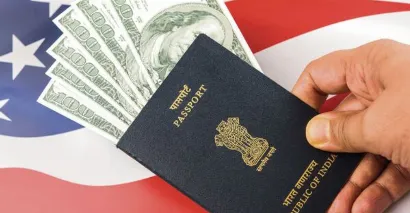Key Highlights
- The $100,000 H-1B Surcharge: A Shock for Skilled Workers
- Enter the $250 Visa Integrity Fee
- Why the US Is Imposing the Integrity Fee
- Combined Impact: Layered Costs for Visa Seekers
- Implications for Applicants, Employers, and Students
- Challenges, Criticisms, and Unanswered Questions
- Strategies to Mitigate the Financial Shock
- Broader Significance & Policy Risks
- Conclusion
And the US immigration system is becoming a new point of contention because it is set to introduce a new $250 Visa Integrity Fee on all non-immigrant visa applicants by October 1, 2025, only weeks following its introduction of a $100,000 surcharge on new H-1B petitions filed by September 21, 2025. The headline-grabbing surcharge drove a big share of the news, but the Integrity Fee becomes a bigger and more widespread cost burden - one that would not only affect H-1B applicants but nearly all foreign travelers or professionals in need of entry to the US. We demystify the implications, challenges, and strategies in this blog of those impacted by these stratified visa costs.
The $100,000 H-1B Surcharge: A Shock for Skilled Workers
Then, in mid-2025, the Trump administration announced a massive alteration in fees: all new H-1B petitions submitted on and after 12:01 a.m. ET, September 21, 2025, will include an extra surcharge of $100,000. The impact of this surcharge is to increase the true entry cost of hiring foreign professionals, particularly those not US citizens or new petitions (including the quota of the lottery), making it both more expensive and possibly risky to have foreign talent sponsored by a company.
Both startups and small tech companies, as well as companies that have an intense dependence on international talent pools, especially those that are heavily sourced in high-sending countries such as India and China, will be particularly exposed to the heat.
Also Read: US Visa Rules: India's Third-Country Application Era Ends
Enter the $250 Visa Integrity Fee
As the industry is still struggling with the sticker shock, another fee is looming ahead. As of October 1, 2025, every non-immigrant visa applicant (i.e. visa other than immigrant/green card petitions) must pay a mandatory Visa Integrity Fee in the amount of 250 dollars. The fee will cover a blanket of visa types, which include but are not limited to:
-
B-1 / B-2 (Business / Tourist visas)
-
F / M (Student visas)
-
H-1B (Work visas)
-
J (Exchange visitor visas)
The charge is not negotiable and is obligatory, but an individual who fulfills visa conditions to the letter, the departure from the US on time, and maintains status conformity may be refunded. Nevertheless, the procedure of the refund is supposed to be cumbersome and obscure.
Why the US Is Imposing the Integrity Fee
The above-mentioned intention of the Integrity Fee is to improve visa enforcement and decrease abuses of the non-immigrant visas. The government hopes to increase the cost of entry by adding this fee and prevent fraudulent or abusive visa actions.
But since the fee is widely used, it not only inherently affects individuals who are suspected of misuse, but also just about every visitor, student, professional, and exchange participant. The consequence is some form of cross-subsidy: those who are entitled to it now have to bear enforcement costs.
Combined Impact: Layered Costs for Visa Seekers
The H-1B surcharge of 100,000 dollars and the Visa Integrity Fee of 250 have produced a tiered cost system that dramatically changes the financial situation of both the applicants and employers. This surcharge of $100,000, which will become operational on September 21, 2025, will apply to the new H-1B petitions and to employers who will file a new case. This action significantly increases the price of sponsoring foreign professionals, especially in areas that have a high demand for talented international professionals.
Conversely, the Visa Integrity Fee of $250 that is imposed on October 1, 2025, will be charged on all types of non-immigrant visas, such as B, F, H, and J categories. This fee should be paid by the applicants, unlike the surcharge, which is paid by the government. It is not waivable but may be refunded in case the applicant keeps to the conditions of the visas.
To most Indian applicants who are already struggling with the high visa fees, documentation fees, and service fees, these added layers of charge will come as a steep increase in the overall cost of acquiring a US visa. Such a twofold burden is an added strain on the finances of individuals and sponsoring firms, which makes the US visa acquisition process even more difficult.
Also Read: US Visitor Visa B1/B2
Implications for Applicants, Employers, and Students
Implications for applicants, employers, and students are:
To H-1B Applicants and Their Employers
-
The employers are now forced to think of the abrupt, drastic increase in their expenses. The surcharge of 100,000 will make some of them hesitate to sponsor or will make them refocus on whom to sponsor.
-
It is also up to the applicants to consider the $250 Integrity Fee, which they will have to put out of pocket themselves.
-
Such a chance of refunding the Integrity Fee can be somewhat relieving- as long as the process is transparent and manageable.
For Non-H-1B Visa Holders
-
The additional cost on the visa application process is an addition of 250 dollars for students (F / M visas), exchange visitors (J visas), business or tourist travelers (B visas).
-
Even individuals who never imagined the H-1B surcharge are being impacted now, with widespread hikes in costs on non-immigrant types of visa.
-
In the case of Global Talent Mobility and US Competitiveness.
-
US companies and, in particular, startups and mid-sized firms can reconsider the aggressive approach to recruit foreign workers, especially those that belong to high-cost geographies.
-
Applicants in India, China, and other areas that are exporters of tech talent might see US avenues relatively unappealing.
It has a possibility of creating a chilling effect on mobility, exchange, and academic cooperation.
Challenges, Criticisms, and Unanswered Questions
Challenges, criticisms and unanswered questions:
Refund Complexity
The fact that the applicants who follow the requirements to the letter will have their money back is encouraging. However, the process is going to be tedious, bureaucratic and slow. Some of them might not receive the refund or might not receive it at all.
Goal of Barrier to Access vs. Enforcement
Some critics note that even though the Integrity Fee is being sold as an enforcement tool, it is also a barrier to entry, particularly among those who have relatively small financial resources.
Risk of Litigation and Lawsuits
The H-1B surcharge of 100,000 dollars specifically has already attracted criticism on the part of business organizations and lobby groups. Courtroom battles can arise as to whether such surcharges are legal, particularly where they are perceived as arbitrary or punitive.
Influence on Demand and Behavior of Applicants
The applicants may postpone and apply to other destinations (such as Canada, Europe), or resort to remote work instead. The rise in the fees can change talent flows.
Visa Administrative Workload on Visa Agencies
Refunding, compliance enforcement, and handling appeals and disputes will further increase administrative burdens in the US consular and immigration processes.
Also Read: How Many Types of Visa in the USA? New Full Expert Guide
Strategies to Mitigate the Financial Shock
-
Early Filing: In the case of applicants who intend to file H-1B petitions, exposure may be minimized by filing earlier than the effective window of the surcharge (where applicable or possible).
-
Budget Buffers: The fee of 250 dollars to gain integrity (and the additional charge, when applicable) should now be part of the cost estimation of the applicants and employers.
-
Inquire about Exemptions or Waivers (Where Applicable): Technically, they are non-waivable, but advocacy and legal proceedings may lead to carve outs or exemptions- applicants should keep track of politics.
-
Ensure Flawless Visa Compliance: Since any refund depends on compliance (leaving on time, no status violations), the applicants must avoid any infractions.
-
Think of Other Visa/Comparison Grounds: Some can think of other visa paths, like employment categories that are not surcharged, or working remotely.
Broader Significance & Policy Risks
These two-fold charges are a revolutionary step in the US immigration process, financing, and its visa programs. The burden is being directly imposed on foreigners who want to enter, instead of the taxpayer funding or general appropriations.
However, this policy has risks:
-
Weakening of the US appeal to the world as the best talent source.
-
Domestic and international legal and political backlash.
-
Any possible retaliation or a reciprocal visa fee by other nations.
It is yet to be understood whether this overlay of charges eventually meets the above objectives of enforcement and reduction of misuse, or it diminishes the soft power of the US in talent attraction.
Conclusion
With the US proceeding to add two layers of fees, the $100,000 H-1B surcharge and the $250 non-immigrant Visa Integrity Fee, the visa compliance, enforcement, and bureaucratic fee burden is being further distributed between applicants and employers. What started as a headline tax on highly skilled professionals has now grown into a general surcharge on all temporary visitors and workers.
Among H-1B applicants, technology companies, students, and international professionals, such modifications require serious budgeting, adhering to timing, and keeping a keen eye out for possible legal or policy withdrawals. Although this would help discourage abuse and add to stronger enforcement, the spike in visa prices could also alter the trends in international mobility, and this would also question the attractiveness of the US as a talent destination.
Contact TerraTern for more information.








